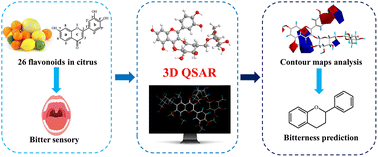3D-QSAR studies on the structure–bitterness analysis of citrus flavonoids†
Abstract
Despite their important bioactivities, the unpleasant bitter taste of citrus derived flavonoids limits their applications in the food industry, and the structure–bitterness relationship of flavonoids is still far from clear. In this study, 26 flavonoids were characterized by their bitterness threshold and their common skeleton using sensory evaluation and molecular superposition, respectively. The quantitative conformational relationship of the structure–bitterness of flavonoids was explored using 3D-QSAR based on comparative molecular field analysis (CoMFA) and comparative molecular similarity index analysis (CoMSIA). The results showed that increases of a hydrogen bond donor at A-5 or B-3′, a bulky group at A-8, or an electron-withdrawing group at B-4′ would enhance the bitterness of flavonoids. The bitterness of some flavonoids was predicted and evaluated, and the results were similar to the bitter intensity of the counterparts from the 3D-QSAR and contour plots, confirming the validation of 3D-QSAR. This study explains the theory of the structure–bitterness relationship of flavonoids, by showing potential information for understanding the bitterness in citrus flavonoids and developing a debittering process.



 Please wait while we load your content...
Please wait while we load your content...